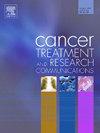评估尼达尼布/多西他赛在免疫治疗和化疗后晚期/复发性非小细胞肺癌中的疗效、安全性和预后/预测因素:加利西亚肺癌组的一项研究
IF 2.4
Q3 Medicine
引用次数: 0
摘要
化疗和免疫检查点抑制剂(ICIs)后进展的晚期非小细胞肺癌(NSCLC)患者需要有效的二线治疗。尼达尼布和多西他赛的联合治疗显示出了希望,特别是在ici后的进展。本研究在加利西亚肺癌组的队列中评估了该方案的有效性、安全性和预后因素。材料和方法这项观察性、多中心、回顾性研究纳入了45例晚期或转移性非小细胞肺癌患者,这些患者在接受至少一种免疫治疗和化疗后进展。所有患者均接受尼达尼布和多西他赛治疗。总生存期(OS)、无进展生存期(PFS)和不良事件分析采用描述性和推断性统计,包括Kaplan-Meier生存分析。结果中位年龄61岁,男性占69%。二线和三线的疾病控制率分别为59.1%和37%。中位OS为20个月(95% CI: 15-25)。亚组分析显示,LDH水平升高(246 UI/L)与OS改善相关(HR = 0.38;95% ci: 0.18-0.77)。高PD-L1表达(≥50%)与更长的生存期相关(HR: 0.48;95% CI: 0.18 - 1.25),而主动吸烟与较差的结果相关(HR: 1.06;95% ci: 0.40-2.78)。≥3级毒性包括腹泻(6.7%)、血液学毒性(13.3%)、肝毒性(4.5%)和呕吐(2.2%)。结论尼达尼布和多西他赛在免疫治疗和化疗失败的晚期非小细胞肺癌中显示出有意义的疗效和可接受的安全性。LDH、PD-L1和吸烟状况是重要的预后因素,需要进一步的前瞻性研究。本文章由计算机程序翻译,如有差异,请以英文原文为准。
Assessment of efficacy, safety, and prognostic/predictive factors of nintedanib/docetaxel in advanced/recurrent non–small cell lung cancer post-immunotherapy and chemotherapy: A Galician Lung Cancer Group study
Introduction
Patients with advanced non-small cell lung cancer (NSCLC) who progress after chemotherapy and immune checkpoint inhibitors (ICIs) need effective second-line treatments. The combination of nintedanib and docetaxel has shown promise, particularly post-ICI progression. This study evaluates the efficacy, safety, and prognostic factors of this regimen in a cohort from the Galician Lung Cancer Group.
Materials and Methods
This observational, multicenter, retrospective study included 45 patients with advanced or metastatic NSCLC who had progressed after at least one line of immunotherapy and chemotherapy. All received nintedanib and docetaxel. Overall survival (OS), progression-free survival (PFS), and adverse events were analyzed using descriptive and inferential statistics, including Kaplan-Meier survival analysis.
Results
The median age was 61 years, with 69 % male. The disease control rate was 59.1 % in the second line and 37 % in the third line. Median OS was 20 months (95 % CI: 15–25). Subgroup analysis showed that elevated LDH levels (>246 UI/L) were associated with improved OS (HR = 0.38; 95 % CI: 0.18–0.77). High PD-L1 expression (≥50 %) was linked to longer survival (HR: 0.48; 95 % CI: 0.18– 1.25), while active smoking correlated with worse outcomes (HR: 1.06; 95 % CI: 0.40–2.78). Grade ≥3 toxicities included diarrhea (6.7 %), hematologic toxicity (13.3 %), hepatic toxicity (4.5 %), and vomiting (2.2 %).
Conclusions
Nintedanib and docetaxel demonstrated meaningful efficacy and an acceptable safety profile in advanced NSCLC after immunotherapy and chemotherapy failure. LDH, PD-L1, and smoking status emerged as important prognostic factors, warranting further prospective studies.
求助全文
通过发布文献求助,成功后即可免费获取论文全文。
去求助
来源期刊

Cancer treatment and research communications
Medicine-Oncology
CiteScore
4.30
自引率
0.00%
发文量
148
审稿时长
56 days
期刊介绍:
Cancer Treatment and Research Communications is an international peer-reviewed publication dedicated to providing comprehensive basic, translational, and clinical oncology research. The journal is devoted to articles on detection, diagnosis, prevention, policy, and treatment of cancer and provides a global forum for the nurturing and development of future generations of oncology scientists. Cancer Treatment and Research Communications publishes comprehensive reviews and original studies describing various aspects of basic through clinical research of all tumor types. The journal also accepts clinical studies in oncology, with an emphasis on prospective early phase clinical trials. Specific areas of interest include basic, translational, and clinical research and mechanistic approaches; cancer biology; molecular carcinogenesis; genetics and genomics; stem cell and developmental biology; immunology; molecular and cellular oncology; systems biology; drug sensitivity and resistance; gene and antisense therapy; pathology, markers, and prognostic indicators; chemoprevention strategies; multimodality therapy; cancer policy; and integration of various approaches. Our mission is to be the premier source of relevant information through promoting excellence in research and facilitating the timely translation of that science to health care and clinical practice.
 求助内容:
求助内容: 应助结果提醒方式:
应助结果提醒方式:


